50 Ways to Leave Your Summer
by Carrie Steele with Kat Bennett, Danita Boonchaisri, Janice F. Booth,
Dotty Doherty, Dennis Doyle, Helena Mann-Melnitchenko and Sandra Olivetti Martin
Martin
Yes, we too are sorry it’s going. But the fresh air of September opens such high horizons that we feel buoyant as a blimp and ready to rise. Read along and find 50 fine ways to turn over a new leaf in Chesapeake autumn.
1. Bookend Your Summer
Return to places and people you encountered at summer’s start. Reminisce about the traditions of the season and savor recent memories — like Fourth of July, which is now nearly two months past.
top of page
2. Celebrate the Equinox
This year’s crossroads of summer and fall comes 12:03am Saturday, September 23, with the autumnal equinox. On this day — as on the vernal equinox six months away — our hours are evenly divided between sunlight and darkness. It’s been celebrated as a harvest festival throughout the ages, often with the help of abundant wine, so you can get a little wild and blame it on tradition.
top of page
3. Eat a Crab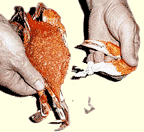
Crab feasting is never better than in autumn, when Callinectes sapidus are bigger, sweeter, cheaper and more plentiful. Buy a dozen or a bushel at a roadside stand or a seafood market (they’ll cook them for you) and invite your friends over. Or bring your crab hunger to a local crab house.
top of page
4. Plant Trees
Dig into a tree-planting project to beautify land and purify air and water. One acre of trees can absorb as much carbon dioxide as a car emits in 26,000 miles. Annapolitans join neighbors for the great Annapolis tree give-away, helping the city reach its goal of raising its urban tree canopy cover from 41 to 50 percent by 2036. Be at Truxton Park Pool, between 9am and 5pm on Tuesday, September 26, to choose from 10 trees, from shade varieties of red maple and pin oak to ornamental redbuds and Kousa dogwoods; plus evergreens. Bring a vehicle that can hold a five-gallon tree and sign a waiver that your tree will be planted within city limits.
top of page
5. Celebrate Going Back to School
No matter what your age, make a holiday of your annual outing for special clothes, art supplies or a backpack. Go to town, have lunch in a restaurant, visit a museum.
top of page
6. Bury Anne Arundel Hibiscus
Plant hardy native swamp hibiscus outside in any sunny, damp area. Keep soil moist, and you can expect dinner plate-sized flowers from early July until the first frost of every year after.
top of page
7. Savor the Changing Season
Step outside. Stop. Close your eyes. Take a deep breath.
top of page
8. Find Fall Wildflowers
Scout for autumn wildflowers, which perk up for a final show before winter. Hike around Chesapeake Country and you’ll see asters, goldenrod, tickseed sunflowers and bouquets-ful more.
top of page
9. Send Summer a Sailor’s Valentine
Gather summer’s shells (or make a last quick trip to the beach). Place two matching shells or a small photograph in the center of a framed plywood square or box. Glue shells in geometric patterns until all the space is filled. Date, sign and hang as a reminder of the summer past.
top of page
10. Bake Apple Pie 
• The Crust
2 cups flour, 1 tsp. salt, 1/2 tsp. sugar,
3/4 cup shortening, 1 egg, 1 tbs. vinegar,
1/4 cup water
Mix the dry ingredients in a bowl, and cut in the shortening with a pastry blender. In a separate bowl beat together egg, vinegar and water. Mix with the dry ingredients and refrigerate dough for at least two hours before rolling out. Makes a nine-inch two-crust pie.
• The Filling
In a large bowl stir together:
2/3 cup sugar, 2 tbs. flour, 1/2 tsp. cinnamon, 1/4 tsp. nutmeg, 1/8 tsp. ginger,
1/4 tsp. salt, 1/2 tsp. grated lemon rind
Add and toss to coat: 5 cups peeled apples, thinly sliced
• The Pie
Spread apples in 9-inch pastry pan. Dot with 1 tbs. butter cut into bits. Cover with top crust. Slit decoratively, brush with 1 tbs. heavy cream. Sprinkle with 1/2 tsp. sugar. Bake 1 hour at 350 degrees.
top of page
|
11. Make Room for Mums
Plant fall’s last bloomer, the mum, for your garden’s last hurrah before winter. Mums oversee your yard’s autumn transition as plants brown and leaves trickle down from the trees. Scour roadside stands, church bazaars and pick-your-own fields. Visit a celebration of mums each year at Doepkens’ Farm in Davidsonville, where they’ve planted a huge mum mural, which blooms with different colors as autumn progresses. Find out what in September, because mum’s the word.
top of page
12. Cheer the Home Team
See the home team defend its turf, whether it’s Navy football or soccer, or your local high school’s teams. Wrap up in a blanket as you perch on metal bleachers and admire the athletic stamina of students. If it’s a big game, dine on hot dogs or bring your own Thermos of hot chocolate to warm cold hands.
top of page
13. Sing Pumpkin Carols
Throw an old-fashioned harvest party with cider and apple-bobbing, a campfire, maybe even a hayride and barn dance. Or just drink a lot of cider and sing to the Great Pumpkin:
Great Pumpkin is Coming to Town
Oh, you better not shriek
You better not groan
You better not howl
You better not moan
Great Pumpkin is coming to town
He’s gonna find out
From folks that he meets
Who deserves tricks
And who deserves treats
Great Pumpkin is coming to town
He’ll search in every pumpkin patch
Haunted houses far and near
To see if you’ve been spreading gloom
Or bringing lots of cheer
Oh, you better not shriek
You better not groan
You better not howl
You better not moan
Great Pumpkin is coming to town
Deck the Patch
Deck the patch with orange and black
Fa la la la la, la la la la
Take along your goodie sack
Fa la la la la, la la la la
Don we now our gay apparel
Fa la la la la, la la la la
Troll the ancient pumpkin carol
Fa la la la la, la la la la
See the Great One rise before us
Fa la la la la, la la la la
As we sing the pumpkin chorus
Fa la la la la, la la la la
Follow him as he ascends
Fa la la la la, la la la la
Join with true Great Pumpkin friends
Fa la la la la, la la la la
top of page
14. Mind Your Garden
Your garden needs attention. Pull out the spent zinnias and cosmos. Make room for the most beautiful September flowers, the asters, in purple, pink and white. Cut a few for the dining room table.
top of page
15. Visit Cemeteries
Fall is the time to visit cemeteries. There’s something about the dying year that befits that endeavor. It’s no coincidence that Halloween with its spooks is around the corner. Linger over fading inscriptions. As you walk to the other leaning headstones, you recognize one pattern: young women dying in childbirth. History is written in those dates.
top of page
16. Paddle Your Canoe
Push off on a crisp autumn morning, slipping your canoe into cooler waters for a fall paddle. Watch the sun rise and the big fish chase the little ones. The orange and green tangle of vines and bushes on the shore make an exquisite tapestry.
top of page
17. It’s Hip to Be Square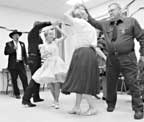
It’s impossible not to have fun square dancing
story & photos by Danita Boonchaisri
I was clear from the very beginning; I did not come to dance. I had done the obligatory cavorting in fifth grade as part of the school system’s ruse to encourage appropriate boy/girl interaction, and I was still vaguely familiar with the basic do-si-do and promenade. But my square dancing days were more than 30 years behind me, and I had no intention of reliving them this Friday night.
I had come simply for the intrigue; beckoned by the two words that completed a short paragraph in Calvert County’s Parks & Recreation Guide: “Visitors welcome.” I wanted only to observe and satisfy my curiosity about what I thought certainly could not be true. Do people still actually square dance? And if so, why?
The Dance Party
The Dancers’ Pledge
With all my ability I will do my best to help keep square dancing the enjoyable, wholesome, friendly and inspiring activity I know it to be. This I pledge in the sincere desire that it may grow naturally and unexploited in the coming years and be available to all those who seek the opportunity for friendship, fun and harmony — through square dancing.
|
The room at the Southern Community Center was overly lit, institutional and a bit stuffy on a warm summer evening. But the doors were open, with music and giggles spilling into the parking lot. Purple and black streamers festooned the walls of the room, and a banquet table was laden with all manner of delicacies: cake, salad, sodas, cookies and vegetables with dip.
This was a party. It was graduation night for a new class of Aqua Squares, when novice members of Southern Maryland’s oldest square dancing club would be tested on their ability to follow intricate dance steps, recite pertinent historical information and answer questions about the customs of square dancing in order to become full-fledged club members. The graduates didn’t seem particularly worried about the final exam, though, since there is no penalty for wrong answers or missteps, and the testing is done in the spirit of celebration and fraternity, with only a hint of formality.
Angels, or experienced dancers, coach the novices through dance routines and beam with pride as their charges manage the proper execution of a Ferris wheel or a cloverleaf. The dance moves are still a bit tricky for the newbies, and some of them have difficulty keeping up with the directions of the professional caller, who works nearly as hard as the dancers to keep things on beat. No one seems to mind or even notice the missteps that occur; it’s all part of the delight.
With an average age that appears to be somewhere near retired, the group of 25 pairs off in various combinations throughout the evening so that it becomes impossible to know who belongs together. This is clearly about more than the dance, and in between sets dancers wipe beads of sweat from their hairlines and gather around the pot-luck table to catch up on news from friends, family or other club members who are absent tonight. Throughout the evening, the inquisitive sidle up to me to offer a welcome, see why I’ve come and encourage me to join a square, cut a rug, dance. I return their smiles and insist that I’ve only come to watch, thank you.
The gathering of the Aqua Squares, one of only two square dancing clubs in Southern Maryland, is obviously the high point of the week for its members. “It is impossible not to have a good time while you’re square dancing,” said Paula Ropshaw, the Aqua Squares’ secretary.
The club recently celebrated its 35th anniversary. Only one of the founders remains, but newcomers are enthusiastic and raucous enough to keep spirits high and to ensure that the tightly knit group does not unravel.
More than once an outstretched hand reached into my quiet corner to invite me to the dance floor. In turn, I smiled at one or another kind-faced gentleman and shook my head while pointing to my notepad. I’m writing, after all. I can’t possibly dance.
A Good Call
The breaks don’t last long with this group, and soon the 45-rpm records spin again on the turntable and three or four squares of eight dancers center themselves in the room, prepared to follow the sing-song directions given by the caller
Circle to the left; now circle to the right.
The other way around, sides face.
Do a grand square.
Reverse the other way back and ladies in.
Do-sigh-do, all the way along in an ocean wave.
At the heart of any good square dance is the caller, who carefully guides the swirling couples with theatrical flair. He serves as the conductor, manager and director of the dance sessions, gauging when the group needs a quick step, a beat or two to catch up or a break.
Virgil Forbes has called for the Aqua Squares for nearly 10 years, but he has been a professional caller, honing his craft, for 27 years.
“It takes three to five years to develop the competency and floor judgment to serve as a professional caller,” Forbes says. “There is no bar to anyone becoming a square dance caller,” he adds, “except for the approval of the dancers.”
In watching him orchestrate a few rounds, I see the talent and skill it takes to build the trust to choreograph a room full of people. Since the dancers never know what direction Forbes will give — and he must pace his calls so they don’t stumble or fall behind — he recognizes that their enjoyment depends on his timing.
“Square dancing is the most complex dance form done by average people,” Forbes says. “And to be recognized as a good caller, the dancers only have to say, Hey, we like what you do.”
The Aqua Squares clearly approve of Forbes’ style, so — clad in black western wear and possessing an uncommon zeal for the pastime — he ventures from Laurel once or twice a week to spend a couple hours with the group.
Forbes fancies himself both a facilitator and an entertainer. His confidence and ego are obviously intact this evening as he deftly controls the room. He is the centerpiece, and he relishes the role he plays entertaining these dancers, week after week.
“I love the dancing, but I’m better as a caller,” he admits.
Forbes is all too happy to share his knowledge and insight on square dancing during the short dance breaks. His store of dancing lore and customs is deep, and his tidbits and anecdotes are engaging. But he, like the others, insists that a dance is the best way to satisfy my curiosity.
“You should give it a try,” he says, nodding in the direction of the dance floor.
“No, thanks,” say I. “I’m fine just watching.”
21st Century Squares
The popularity of square dancing has waned over the years.
That’s a trend the Aqua Squares enthusiastically work to reverse. Ropshaw says she would hate to see the activity die. “It is just so much fun,” she says. “Square dancing teaches you to listen and move quickly; it is good exercise for couples or singles, we laugh and share good food, and I just love the outfits — especially the crinolines. You can never have too many crinolines.”
Are You Hip Enough to Be Square?
The Aqua Squares seek new members, and neither experience nor dance partners is necessary. All that is required is a friendly heart and an open mind. Starting in September, the club meets Friday evenings at 7:30 at the Southern Community Center, 20 Appeal Lane., Lusby. As always, visitors are welcome: $5.
The accelerated square dancing course meets Friday, September 22 from 7 to 9pm and from 10am to 10pm Saturday, September 23 at the Southern Community Center. $20; rsvp: Bill or Mary Ann Rymer, co-presidents of the Aqua Squares:
301-863-0064.
|
Having cultivated square dancing for more than three decades, the Aqua Squares continually search for new members to share the fun. In square dancing, the old adage rings true: The more, the merrier.
To entice new dancers, the Aqua Squares have planned for fall a square dancing crash course to teach novices the moves and calls in a fraction of the time.
“Long ago,” says Wilson Master, past president of the club, “there weren’t many community activities, and people looked forward to square dancing as a means of socializing. Today, there are so many things for people to do it is difficult to commit to the many weeks it usually takes to learn the dance moves and calls.”
He hopes the class will bring people up to speed so they can enjoy dancing quickly.
One Last Dance
In the end, I am unable to refuse Forbes’ very public insistence that I join a square for a hands-on experience.
“You will never understand square dancing unless you try it,” he declares.
With all eyes on my bolo tie-wearing partner and me, I promenade with the remnants of grade-school skill that seemed to return from nowhere.
The group approves and is generous with their applause. At the conclusion of my short performance, as I tender the customary bow and thank you to my square partners, I’ve discovered that the dancers were right: It is impossible not to have fun square dancing. On the way home, still beaming from my performance, I wonder how I’d look in a purple bouffant petticoat.
Danita Boonchaisri is a freelance writer from Calvert County. She enjoys writing about Marylanders and the remarkable hobbies and pastimes they pursue. This is her first story for Bay Weekly.
top of page
|
18. Brew Spiced Cider
Warm up with a cup of hot, spiced cider. Mix together a jug of bottled apple cider and three cinnamon sticks in a slow cooker. Then wrap one teaspoon whole allspice and one teaspoon whole cloves in a cheesecloth before tossing in. Stir in one-third cup brown sugar and bring to a boil. Reduce heat and ladle out.
top of page
19. Catch a Fat Fall Fish
Fall fishing gets substantially better as fish get hungrier before winter comes on and they move into tributaries and shallows for abundant bait fish moving downriver. Look for best fishing two hours either side of evening high tides. The darker the moon, the better the fishing. Consult a tide table and a calendar with moon phases, and watch our Sporting Life column.
top of page
20. Lose the Flip-Flops
Cast off summer’s wardrobe of T-shirts, shorts and flip-flops. It’s time to spiffy up. Women might try a deeper, wine-colored lipstick with their skirts, blouses and a pair of soft leather shoes. Maybe even with a little heel. See how good it feels to twirl around in that skirt and heels. Fellows, those shorts decorated with the splatters of barbecues, engine oil from messing around on the boat and a small tear from a fish hook — they have to go. If dress pants and jacket are not your style, how about a new pair of jeans or Dockers and a shirt with a collar?
top of page
21. Cast off a Few Pounds
Pull out your walking shoes and take a two-mile walk. Or a run. Or a kayak trip. No more excuses that it’s too hot or too muggy. The holidays are just around the corner. The average American gains five pounds between Thanksgiving and New Year’s Day. Save yourself now.
top of page
22. Visit a Farm
Revel in an autumn farm. Pet a sheep or a cow. Browse for the perfect pumpkin. Load up on odd gourds. Ride a haywagon and sip apple cider. Some in Chesapeake Country not to miss are Knightongale Farm in Davidsonville; Kinder Park Farm in Millersville; Spider Hall Farm in Prince Frederick. Scout fall farms at www.somarylandsogood.com.
top of page
23. Serve a Sunday Chuckwagon Breakfast
Plan a Sunday Chuckwagon Breakfast. Choose a favorite park that allows grilling or campfires, and invite everyone to bring bacon, coffee, eggs, sausage, grits, pancakes and fresh fruit. Go early in the morning when the park is empty of all but nature.
top of page
24. Watch Migrant Waterfowl
Bid farewell to osprey and greet the ducks, geese and swans of winter. In September, the osprey head to southern climates, along with our wood ducks and Forster’s terns as migrant geese begin to fill the skies. November brings the early ducks, the little round bufflehead and ruddy ducks as well as the larger widgeon and scaup. By mid-November, the haunting strains of the tundra swans grace our Bay beaches; in late December watch for large flocks of canvasback. For large congregations of waterfowl visit Chesapeake Bay Environmental Center, Blackwater National Wildlife Refuge or Eastern Neck National Wildlife Refuge.
top of page
25. Excavate Your Scarf
Recover your scarf from the closet as cooler temps accompany later sunrises. Savor the warmness of its brush against your rosy cheek when you see your breath for the first time this season.
top of page
26. Or Knit a New Scarf
From warm, richly colored yarn spun from the wool of Chesapeake Country sheep, llamas and alpacas at Calvert Country Market’s Ch’naca Fiberworks, where you’ll also find knitting groups most evenings and instruction (Prince Frederick Shopping Center: 877-707-9013).
top of page
27. Open up a Theater
Catch an opening night seat as area theaters start a fresh season of comedies, musicals, dramas and mysteries. Be there as the curtain rises to feel the energy of actors and actresses on that first night. Or wait until Bay Weekly reviewer Dick Wilson gives you the skinny. This fall, you’ll see 2nd Star Production’s The King and I (already in its second weekend); Colonial Players’ Copenhagen; Pasadena Theater Company’s Fiddler on the Roof; Bay Theatre Company’s Deathtrap; Bowie Community Theater’s Rumors; and more. Check 8 Days a Week to see what’s playing.
top of page
28. Lose Yourself in a Maize
Prowl a cornfield-turned-maze for an outdoor adventure.
• Greenstreet Gardens’s two miles of maze trails are shaped like a crab. Traipse the paths September 15 thru October at 391 Rt. 258 in Lothian: 410-867-9500 for directions, hours, fees and special events (including some nights opened for flashlight wanderings).
• Billingsley House Museum’s six-acre cornfield becomes two smiling crabs for fall. Wander this maze Saturdays and Sundays October 1 to 29, noon to 5pm. Billingsley House Museum, Upper Marlboro. Call for directions; $5: 301-627-0730.
• Find your way around a three-acre corn maze at Knightongale Farm in Davidsonville, where you bump into pumpkins and haybale spiders. Weekends September 23 thru October: 443-871-1073.
top of page
29. Fare Well at a County Fair
Loop around the Ferris wheel. Pet a pig. Fill yourself with funnel cake. See the county’s biggest bunny. See how bees make honey. Eat a pie. Cheer on an alpaca. Bet on yourself in a game of chance.
• Anne Arundel County Fair, September 13-17 at the County Fairgrounds, General’s Highway, Rt. 178, Crownsville: www.aacountyfair.org/.
• Calvert County Fair: September 27-October 1 at the Calvert County Fairgrounds, Rt. 231, Barstow: www.calvertcountyfair.com/.
top of page
30. Gather Round a Campfire
Kindle a warm crackling fire at a campsite, or join in one at area nature centers. Don’t forget the S’mores. Keep tabs on 8 Days a Week for upcoming blazes.
top of page
31. Make Pork Barbecue
Rub a pork butt with equal parts black pepper, brown sugar, paprika and salt. Roast the pork over a low, steady fire in a grill or smoker for three to four hours. Shred with a fork. Add your favorite barbecue sauce or use this traditional southern one. Pile onto thick buns with lots of coleslaw. (If the pork does not pull apart easily, place the pork and sauce in a large pot and gently cook until it pulls easily, adding water as needed.)
of Homemade Sauce:
1 cup apple cider vinegar
1/2 cup water
2 tbs. Worcestershire sauce
1 tbs. coarsely ground black pepper
1 tbs. coarse salt
2 tsp. vegetable oil
top of page
32. How to Raise Your Kids and Save Your Sanity
Back to class to learn what school never taught you
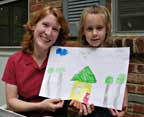 |
|
Art therapist Nancy McCamish and daughter Lydia.
|
story & photos by Janice F. Booth
A sunny garden, leaves rustling in the trees, children napping in their rooms — who would expect monsters to emerge? But they do.
Art therapist Nancy McCamish — who trained at Georgetown University, earning a masters degree — was babysitting a friend’s toddler when an afternoon thunderstorm rumbled through. Her charge woke, screaming. McCamish cuddled the distraught child, then grabbed crayons and paper. In bold, waxy strokes, the two-year-old’s depiction of the monster storm emerged.
This was the very storm raging outside, McCamish and the toddler agreed. “Let’s fold-up this storm and tuck it deep in your sock drawer, where it won’t be able to bother you,” McCamish suggested, and that is what they did. The parents returned to find their child sleeping peacefully, fears mastered, security restored.
Through art, McCamish helps children master their fears and interpret their environment. At Anne Arundel Community College’s Parenting Center, she teaches parents how to use drawing, sculpting and other forms of art therapy to help children deal with anxiety, express their emotions and develop their creativity.
Parenting Center to the Rescue
McCamish found the Parenting Center as a student listening to Dr. Lou Aymard lecture on parenting.
“He used the good-boss-bad-boss metaphor for parenting,” she remembers, and she left feeling “inspired.”
As the mother of three-year-old Aidan and six-year-old Lydia, McCamish appreciates the value of inspiration — in parenting as well as in art.
The McCamish children are two of the more than 122,000 babies, children and teens living in Anne Arundel County, accounting for one-quarter of county population according to the 2004 American Community Survey of the U.S. Census Bureau. Yet not one parent, grandparent, sibling, aunt or uncle got a training manual when a child entered his or her life.
“We need family-centered education,” says the man who inspired her, child psychologist, professor, author and lecturer Lou Aymard.
Five years ago, Aymard retired from his flourishing private practice to realize a vision: an institute providing accessible, affordable and responsible resources for parenting. That vision became the Parenting Center, which has grown from three courses to over 40 and from a faculty of one to 25. Anne Arundel Community College has supplied the Center with physical, financial and professional resources: a suite of offices, advertising, seed money and faculty.
Aymard directs the Center. He has brought together a staff of distinguished professionals in such areas as art and play therapies, nutrition, sleep therapy and drug and alcohol counseling. Ninety-eight percent of the Center’s faculty — child psychiatrists, psychotherapists, family therapists, registered nurses and social workers — are parents too, grappling with the same dilemmas and questions as the people who enroll in their courses.
Avuncular, charismatic and passionate, Aymard never passes up an opportunity to advocate for parents and children, to discuss the tough job of parenting and the struggles faced by both children and those who raise them. He is fond of quoting Alfred North Whitehead: “Our children are the living messages we send to a time we will not see.”
The parents who take these courses are “fellow travelers,” Aymard reminds his faculty. “Nobody’s to blame [if problems arise]; everyone does the best they can.”
Aymard’s students get the message. Lynn Nappari, an adult student at Anne Arundel Community College, has three daughters, one of whom suffers from a serious health condition. Nappari’s first experience with the Parenting Center was Aymard’s course Parenting the Siblings of Children with Special Needs. In it, Nappari learned to discuss with her daughters some of the tough decisions parents must make when the needs of family members conflict. The daughters shared in the decisions — and in their consequences.
“I only wish I’d taken that course earlier, when the girls were small,” Nappari said. “I learned that I didn’t have to make decisions about family resources, time and attention all by myself.”
Learning to Manage
 |
|
Anger management specialist Melissa Kerr with one-year-old Emma and three-year-old Abi.
|
One-year-old Emma and three-year-old Abi are being put to bed by their father, Chris, as Melissa Hallmark Kerr explains her work with anger and stress management. Like many families, the Kerrs are busy people. Chris is a systems engineer working as a contractor for the government. Melissa is a renowned child therapist who wrote The Anger Management Source Book with Dr. Glen Schiraldi.
With a doctorate in public and community health, Kerr studies the relationship between behavior and mental health, particularly how we handle stress and anger. What happens when we’re stressed? We grow edgy, angry. Some of us try to suppress that anger; others let it erupt. Neither approach is particularly good for us. Instead, Kerr recommends “normalizing anger.”
Anger is a common emotion, Kerr reminds her students. Feeling angry is normal. “It’s an experience everybody has,” she says. “We all need practical ways to address the problems [that cause stress and anger] in a safe, loving environment.”
Expressed anger can get out of hand, even destructive. Kerr offers alternative ways to deal with anger, such as a diary or letter, and chances to practice new methods of communicating anger through discussions and role playing.
In the accepting environment of Kerr’s classes, students work in groups on exercises that defuse anger. Her Parenting Center courses in anger management are always full. People sign up, they tell her, because they want to handle their anger more effectively; occasionally because a counselor, spouse, or supervisor has insisted.
“Managing Anger in Family Life is a very spiritual class,” Kerr says. “It gives people a chance. It’s the best kind of self-help. When students do the work, you can see the change.”
What she can teach others may change lives, change people, prevent suffering.
“Recently, I had a young man take this course,” Kerr says by way of example. “He had a large family, worked full time, faced problems in his marriage: Lots going on. Well, he just devoured the course work and reading, and there’s a lot to do and read. Later he e-mailed me that the class saved his marriage.”
Each term, the Parenting Center’s faculty and students write another chapter in their personal how-to manuals on helping children.
The Price Is Right
Therapists charge from $90 to $190 an hour to work with children and their parents. Group counseling sessions are almost as expensive. Therapy means weekly meetings and sometimes time from work for adults.
In that context, Parenting Center courses are a bargain: $45 is the cost for studying with Kerr for six hours over three weeks. That’s also what you pay for two, two-hour class sessions studying with a licensed drug rehabilitation therapist. The time commitment is less disruptive, usually evenings or week-ends.
Rachelle Tannenbaum teaches Parenting Gifted Children. After eight years counseling and teaching such children and their families at Johns Hopkins University, Tannenbaum knows how to help match children with programs and resources and to advise parents on negotiating with their child and with their child’s teachers. The price: $45.
Tannenbaum knows something about managing frustration, too, having dealt with the barriers and stereotypes facing exceptionally bright children. She knows how they’re often unpopular with their peers and overlooked by teachers because she herself is a product of public education’s sometimes hit-or-miss programs for the gifted child.
“Our educational system has no problem recognizing prowess in athletics, but intellectual strengths are overlooked and even ostracized,” Tannenbaum says. Her course helps families advocate for their children and combat those inequities.
What’s In It for You
You don’t have to be comforting a child with nightmares or figuring out how to challenge a brilliant 12-year-old to find an interesting and useful course at the Parenting Center. Courses begin monthly, tackling many of the tough questions responsible adults are asking.
If you’re facing the prospect of caring for an elderly parent, Parenting Our Parents covers the difficult issues associated with helping the elderly while respecting their dignity and independence.
Worrying about how to handle a daughter’s poor eating habits? Registered dietitian and associate professor of nutrition Amy Allen-Chabot — who specializes in proper diet, weight management and eating disorders — teaches Healthy Nutrition for Families.
When your six-year-old asks for a gerbil or a great Dane, enroll in Joseph Lamp’s course on choosing a family pet.
The Parenting Center will bring a course or lecture to your neighborhood action group, church, business or school — or develop a course or lecture to suit your organization’s interests.
The Center has, for example, developed a series of courses responding to the specific needs and values of the Hispanic, the Korean and the African American communities in Anne Arundel County.
When you’re in charge of your book club’s annual children’s litertaure seminar; arrange with the Parenting Center for a session on trends and authors in children and teen literature. Your church retreat might include an afternoon about learning how to help children express their joys and fears through art. Your school might try an in-service day on anger and stress management. Your staff might work under less stress after a half-day seminar on Balancing Work and Family Life.
The Parenting Center, Center for Applied Learning and Technology Anne Arundel Community College at Arnold: 410-777-2159; www.aacc.edu/parenting.
Janice Booth’s Bay Weekly story “Raising Flowers in Fields Where Tobacco Once Thrived” (Vol. xiii, No. 28, July 14, 2005) won first prize in the Maryland, Delaware, D.C. Press Association 2005 editorial competition. She won in the Business-Economic category, beating out three dozen weekly newspapers with circulation of 10,000 to 20,000.
top of page
|
33. Organize Your Summer Fun
Relive summer — from catching white perch to watching Fourth of July fireworks — through the magic of photography. Flip through the prints: your son and daughter proudly display their catch or Uncle Bert floating in the pool. Now, organize them so they’ll last you through next year. Enjoy your summer again, laugh a little, date the photos and put them in albums or special photo boxes. You used a digital camera? Time to sort that on your computer. Don’t forget to take the best shots to a photo center.
top of page
34. Step into Fall
Remember summers past with a walkway, creating a new stepping stone each year. Add summer-gathered pebbles, shells or glass to create a memory.
top of page
35. Follow Fall at a Park
Let cooling temperatures nip you into action outdoors. Meander among burgeoning wildflowers in yellows, blues and delicate lavender along shorelines and across meadows of cajoling butterflies seeking season-ending sips. Revel with trees as they flash final fireworks of color. Celebrate fall by walking, paddling or volunteering. Area parks that open their gates to fall visitors include:
• Jug Bay Wetland Sanctuary where you’ll get wet and muddy fish seining, stream invertebrate identifying or SAV monitoring. Or stay dry and help with marbled salamander research. Pick a plot and rid it of invasive plants: 410-741-9330; www.jugbay.org.
• Smithsonian Environmental Research Center needs volunteers to clear trails but will also take you for a paddle. Check September calendar: 443-482-2300; www.serc.si.edu.
• Patuxent River National Wildlife Refuge and North Tract offer September bird walks, wildflower wanders, butterfly fests, weed pulls and twilight tram tours: 301-497-5587; www.fws.gov/northeast/patuxent.
top of page
36. Gaze the Autumn Heavens
Lift your eyes to the heavenly panorama with the Astronomy Club of Southern Maryland. Meet these amateur and expert astronomers at Jefferson Patterson Park to study the night sky as autumn’s earlier sunsets mean more chances to see stars, planets and comets. Sunset Saturdays September 16, October 14 and November 18. free: 301-602-5251.
top of page
37. Scheme for Halloween
Dream up what you’ll be this Halloween well in advance. You’ll have the time to search for a cape, scour thrift stores for a mask or borrow a friend’s cowboy boots.
top of page
38. Design a Halloween Costume for Your Dog
Turn Fido into a bunny or a doctor. How about Liberitchy, Captain Jack Sparkplug or Marilyn Monrover? Enter this year’s pet costume contest at Quiet Waters Park’s fifth annual Howl-o-ween Barkin Bash, from 11am to 3pm on Saturday, October 28.
top of page
39. Turn Back Your Clock
Mark the end of the harvest season as we set our clocks back one hour to Standard Time, October 29 at 2am. Though most of us aren’t using the extra daylight for reaping our crops, this rite of fall does mean earlier curfews and darker evenings. This is our last year that Daylight Savings occurs on the last Sunday in October. Next year, it will fall on the first Sunday in November, as part of the president’s energy bill to save energy.
top of page
40. Time Travel to the 1800s
Glimpse life for soldiers and civilians during the Battle of 1812 on St. Leonard’s Creek. Re-enactors stage skirmishes and demonstrate camplife, spinning, weaving and blacksmithing. Tavern night rounds out the day at Jefferson Patterson Park on September 30.
top of page
41. Swap Gardens with Neighbors
Organize a day for friends and neighbors to swap their extra plants. Toast with summer’s last glass of lemonade and prepare to dig in when you get home.
top of page
42. Buy or Browse a Boat
Begin your boat hunt now, and your canoe, kayak, powerboat or sailboat will be ready to get you in and around the Bay next spring and summer. Boat shows and auctions coming our way begin this weekend with the Chesapeake Bay Maritime Museum’s 24th annual boat auction, where you’ll find wooden rowing skiffs, classic sailboats and modern power cruisers, donated for sale to benefit the museum (Saturday, September 2, 1-3pm, $10 museum admission: 410-745-2916; preview at www.cbmm.org). Come October, visit Annapolis City Dock to find hundreds of new boats on display for boarding, browsing and buying at the U.S. Sailboat (October 5-9) and Powerboat (October 12-15) Shows. Also browse Bay Weekly classifieds for local opportunity.
top of page
43. Love an Oyster
Maryland’s six-month oyster season opens October 1. But if you can’t bear the thought of swallowing the sweet, slippery nut locked inside that hard-to-pop shell, you can still love an oyster. Celebrate the work our Bay bivalves do in cleaning up the Bay. If you live on the water, plant an oyster garden. (Start with Maryland Sea Grant: www.mdsg.umd.edu/oysters/garden/. Or Chesapeake Bay Foundation: www.cbf.org). Your oysters grow fat by filtering pollutants out of the Bay.
top of page
44. Canoe by Moonlight
Glide into Parker’s Creek at American Chestnut Land Trust at night. Paddle from swamps to coastal salt marsh.
• September 9, 5-8pm: Harvest Moon Guided Canoe Trip
• September 23, 3-6pm: Sunset Guided Canoe Trip
• October14, 9am–noon: Autumnal Guided Canoe Trip
Meet at Warrior’s Rest Sanctuary at the end of Scientists’ Cliffs Road in Port Republic. $10; rsvp: 410-586-1570.
top of page
45. Pick Apples, Eat Apples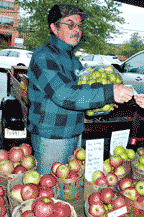
Crunch into a juicy apple this fall. Look no farther than a farmers’ market, Calvert Country Market or roadside stand to round up Galas, Fuji, Granny Smiths, Honeycrisps, Rome, Macintosh, Courtland and many more. Find apple-picking at www.somarylandsogood.com/smhd/index.asp.
top of page
46. Craft a Pumpkin Creation
Pick your pumpkin early this year to decorate or carve. Take your time refining your design — a scary tree, a frightened cat or a jovial face — so you’ll be ready to carve on Halloween.
top of page
47. Save the Pumpkin Seeds
Rescue pumpkin seeds from the pulp while you’re carving. Rinse in cool water and soak them in melted butter for a few minutes. Then lay them on a foil-covered baking sheet and sprinkle with salt. Bake at 250 degrees. Cool and serve as a crunchy fall treat.
top of page
48. Tug Mightily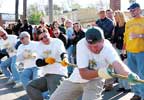
Pull with all your might at the Ninth Annual Tug of War between Annapolis and the Maritime Republic of Eastport Saturday, November 4 at high noon. You’ll support local charities by tugging or cheering: www.themre.org/.
top of page
49. Hunt the Harvest Moon
Greet this year’s Harvest Moon, which rounds out on October 7. Traditionally, farmers work late into the night by the light of this moon. But anyone can enjoy a full moonrise.
The Harvest Moon rises almost due east and hangs low against the horizon, looking unusually large. This is a trick of the eye called the Moon Illusion. When overhead, the moon provides few cues to its distance, so our eyes see it as one or two meters away — even though we know it is thousands of miles away — making it look smaller than normal. When against the horizon, other objects such as buildings and trees give us distance clues that the moon is much farther away, and we perceive it as being larger than normal.
top of page
50. Turn a New Learning Leaf
All ages can learn new skills, hone hobbies and delve into new realms. This fall, you’ll find a preceptorial on George Eliot: Middlemarch, as well as drawing and pottery classes at St. John’s College. Or take a non-credit course in a range of interest areas at Anne Arundel Community College, including Basic Feng Shui or the culinary class Terrific Tailgating. At the College of Southern Maryland in Prince Frederick, hone your skills and hobbies in classes like Expression Through Poetry, Public Speaking Survival Skills and The Big Band Era: Sounds of the 30s and 40s. Get emergency-ready with a CPR or first aid class from Calvert Memorial Hospital. Or check out dance or art classes at Maryland Hall.
top of page







 Martin
Martin









